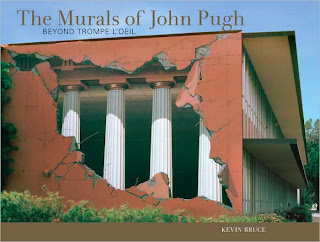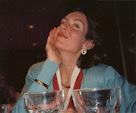Now that you've seen some of my trompe l'oeil painting, in my last post, let me introduce you to some incredible-holycow-knock-your-sock-off works by other artists. Art history is full of examples of trompe l'oeil painting, going back as far as Roman pompeii. In fact, the genre has never faded from popularity since the Renaissance, and has been used for both fine art paintings, as well as murals in homes, castles, churches and other public buildings, for centuries. As a child, I remember seeing trompe l'oeil paintings and wishing I could do something similar "some day". I first studied this type of painting when I was in college (one of my majors being Art History). Then studying abroad, and traveling throughout Europe, I was absolutely taken with actual examples of trompe l'oeil painting on walls, ceilings, building facades, etc., and I have been in love ever since!
The art of trompe l'oeil is painstakingly slow. It is the artist's meticulous attention to detail, including light and shadow, that make two-dimensional paintings appear to be 3D. In the 1960's, artists like Richard Estes and Chuck Close began experimenting with photorealism and then came superrealism - all basically the same thing - trompe l'oeil painting, to fool the eye of the beholder into perceiving the work of art as real life.
HISTORIC EXAMPLES OF THE ART
One of my favorite examples of this art form is Escaping Criticism (above) by the Spanish artist, Pere Borrel del Caso, in 1874. It incorporates a tongue-in-cheek attitude that is present in many trompe l'oeil paintings. Because the artist is trying to fool the viewer's eye, he or she often injects an element of fun into the fooling. In other words, the trompe l'oeil artist deliberately attempts to trick the viewer, but then makes sure the viewer realizes it, too.
The Bachelor's Drawer, by Dutch painter, John Haberle, c. 1890, depicts everyday objects that remain popular subjects of trompe l'oeil paintings to this day: photos, postcards, money, playing cards, stamps, tickets and other personal items. Following are more examples of this charming theme:
Edward Collier, c. 1699
Johann Heinrich Fussli, 1750
Cornelius Gijsbrechts, 1671
Trompe l'oeil also exists beyond the realm of the canvas and plaster surface. Here is a late 19th c. French majolica plate.
MURALS - OLD & NEW
Painted murals on walls - both interior (including ceilings) and exterior - have been popular since trompe l'oeil was invented. In fact the first known examples of the style were on the walls of villas at Pompeii, so it's safe to assume that they go back into dates B.C.
Contemporary French ceiling
Above two, Bunny Mellon's greenhouse at Oak Springs with trompe l’oeil murals by Fernand Renard.
Above four, by Graham Rust. He is my favorite muralist. I have all of his books and find his work to be so inspirational.
Building in Tehran
Mark Harper
Two above, by Michael Potter
Building facade in Brussels, covering the exterior of the new Magritte Museum before it opened. According to one of my readers, Hugo H., behind the "curtain" you can see Magritte's probably most famous painting, "Her Rijk Der Lichten" (The Empire of Lights).
Yannick Geugan
Ceiling detail by Yves Lanthier
TROMPE L'OEIL TODAY
There are so many living artists doing incredible trompe l'oeil work. Here is just a small sampling of some of these talents:
Five above, by David Brega
Donald Clapper has done a series of paintings entitled "Which stamp is real?"
Three above, by Miriam Escofet
Three above, by Michael Theise
Two above, by Robert Jackson
Five above, by Sydney Bella Sparrow
Michael James Riddet
EXAMPLES OF PHOTOREALISM
Two paintings above, by Chuck Close
CONTEMPORARY TROMPE L'OEIL THAT'S WAY OUTSIDE THE BOX

Edgar Mueller does incredible street art that is seriously mind twisting. (Two examples, above)
Above two pavement art pictures by Julian Beever.
Guido Daniele paints on human hands and bodies, for advertising, as well as fine art.
* * *
There are numerous books on trompe l'oeil - of varying qualities. Here are some I think are worth reading:
A Trick of the Eye: Trompe l'Oeil Masterpieces, by Eckhard Hollmann
Trompe l'Oeil Panels, by Yannick Guegan
The Handbook of Painted Decoration, by Yannick Guegan
The Painted House, by Graham Rust
Decorative Designs, by Graham Rust
The Painted Ceiling, by Graham Rust
Brand new: Revisiting the Painted House, by Graham Rust
One thing I appreciate about the four Graham Rust books, above, is that they do not duplicate each other. They are all loaded with fresh ideas and pictures.
The Art of Trompe l'Oeil Murals, by Yves Lanthier
The Art of Faux, by Pierre Finkelstein
Artifice & Illusion - The Art and Writing of Samuel Van Hoogstraten, by Celeste Brusati
The Rhetoric of Perspective: Realism and Illusionism in Seventeenth-Century Dutch Still Life Painting, by Hanneke Grootenboer

















































































